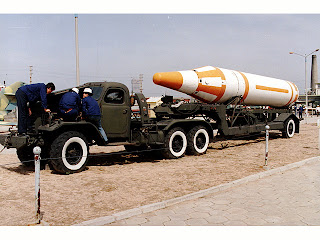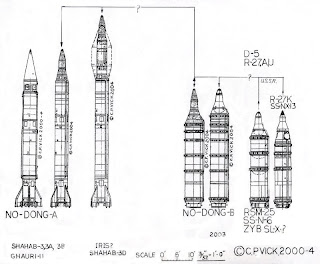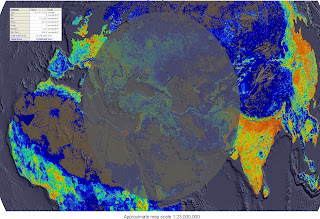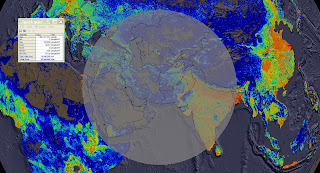Missile Defense 101 – The Threat
 Musudan, North Korea: 0307Z 31 August 1998. On the pad stands an intelligence surprise – a three-stage developmental ICBM which on this day, will attempt to place a small satellite on orbit, broadcasting the immortal hymns of The Dear Leader. Flying over Japan and ultimately self-destructing over the Pacific Ocean, the launch will nonetheless stun the intelligence community (itself later charged by the 9/11 Commission with a “failure of imagination” after another surprise in 2001) and the world – the US and Japan in particular. One year later, Congress would pass and President Clinton sign into law, the National Missile Defense Act of 1999 stating in part:
Musudan, North Korea: 0307Z 31 August 1998. On the pad stands an intelligence surprise – a three-stage developmental ICBM which on this day, will attempt to place a small satellite on orbit, broadcasting the immortal hymns of The Dear Leader. Flying over Japan and ultimately self-destructing over the Pacific Ocean, the launch will nonetheless stun the intelligence community (itself later charged by the 9/11 Commission with a “failure of imagination” after another surprise in 2001) and the world – the US and Japan in particular. One year later, Congress would pass and President Clinton sign into law, the National Missile Defense Act of 1999 stating in part: "It is the policy of the United States to deploy as soon as is technologically possible an effective National Missile Defense system capable of defending the territory of the United States against limited ballistic missile attack (whether accidental, unauthorized, or deliberate) with funding subject to the annual authorization of appropriations and the annual appropriation of funds for National Missile
Defense."
Right now, in 2007, there are only two potentially hostile countries that can reach the US with their active/deployed ICBM inventory – Russia and China. Of the two, Russia’s is the most robust and diverse in terms of launch platform, throw-weight, decoys/penetration aids and megatonnage. Its capabilities far outstrip almost anything the current limited capabilities of the BMDS have, save a possible accidental/rogue launch of a single missile. As such, this series of articles will not focus on the Russian threat.
The quantity and quality of China’s ICBM force is growing well beyond the early limitations of the CSS-4, but it is doubtful that the Chinese ICBM inventory will approach anything equating to Russia’s for a variety of reasons. For a worthwhile read on China’s nuclear force and approach to deterrence, read Jeffrey Lewis’ The Minimum Means of Reprisal: China’s Search for Security in the Nuclear Age (available through
MIT Press).Besides the US, China strategists also have to consider India, Russia and of course, Taiwan and any foreign interests that would come to her aid. Useful in meeting these concerns are a very large and rapidly growing inventory of dual-capability use MRBMs and IRBMs. While some future elements of the BMDS (e.g., Airborne laser (ABL) and Kinetic Interceptor (KI)) may be employed against these threats in the boost phase, today they will primarily be met either via conventional strikes against launchers (hard enough to do vs. mobile launchers deep in China) or more likely, in the mid-course or terminal phase by theater systems like AEGIS/SM-3 (blk Ib or blk II), PATRIOT and THAAD. Garnering particular interest is the CSS-5/DF-21.
 The DF-21 (NATO code name: CSS-5) is a two-stage, solid-propellant, single-warhead medium-range ballistic missile (MRBM) system developed by China’s Changfeng Mechanics and Electronics Technology Academy (also known as 2nd Aerospace Academy). The missile design is based on the two-stage JL-1 submarine-launched ballistic missile (SLBM). The DF-21 is capable of delivering a 500kT nuclear warhead over a distance of 1,800km. The improved DF-21A was introduced in 1996. The missile’s CEP is estimated to be about 300~400m. The missile carries a single 100kT, 200kT, or 500kT nuclear warhead, but can also configured to carry conventional HE warheads – which, given advancing Chinese capabilities and interest in foreign developments, can be presumed to include submunitions. Additionally, there are reports in some quarters that a MaRV variant is being tested that would provide limited maneuverability in the terminal phase to improve accuracy or attack a mobile target (e.g., carrier strike group).
The DF-21 (NATO code name: CSS-5) is a two-stage, solid-propellant, single-warhead medium-range ballistic missile (MRBM) system developed by China’s Changfeng Mechanics and Electronics Technology Academy (also known as 2nd Aerospace Academy). The missile design is based on the two-stage JL-1 submarine-launched ballistic missile (SLBM). The DF-21 is capable of delivering a 500kT nuclear warhead over a distance of 1,800km. The improved DF-21A was introduced in 1996. The missile’s CEP is estimated to be about 300~400m. The missile carries a single 100kT, 200kT, or 500kT nuclear warhead, but can also configured to carry conventional HE warheads – which, given advancing Chinese capabilities and interest in foreign developments, can be presumed to include submunitions. Additionally, there are reports in some quarters that a MaRV variant is being tested that would provide limited maneuverability in the terminal phase to improve accuracy or attack a mobile target (e.g., carrier strike group).
North Korea and Iran: Les méchants jumeaux
We begin with North Korea, for it is NK that by far, has sought the hardest to exploit and develop an indigenous missile development and manufacturing industry and concurrently, has the worst track record for proliferation. Beginning with reverse engineering of Scud-B and –C models, provided by Russia and technology supplied by China and stolen on the market, North Korea has steadily grown its own capabilities while cultivating a clientele of the world’s pariah nations for export of missiles and/or technology. Among the notables on the list are Yemen, Syria, Pakistan, from whom, it is believed, NK received the technology needed for its nuclear weapons development program, via the notorious
A. Q. Khan, and Iran. The pantheon of missiles produced by NK include the SCUD series with ranges of 300-650 km (more of a threat to the South), the No Dong (also known as Ro Dong) MRBM with a range of 1,300 km, the 2-stage variant of the (still to successfully launch) Tae Po Dong 1 and, in particularly disturbing development, a new IRBM, the Musudan, allegedly revealed at the April Military parade. The Musudan is alleged to have been developed from the Russian SS-NX-6 with a range of 5,000 km, bringing distant targets such as Guam within range. Other sources claim a more modest 3,200 km based on the original SS-N-6 (mod) range estimates. Still, this is troubling on several counts – one being that it departs from what has been a development cycle based on SCUD technology and design (itself a legacy of Soviet copies and enhancements of German V-2s) and thereby provide a more robust avenue of development. As a single staged missile with storable liquid propellant, it would also be significantly easier to conceal both the missile and support facilities as well as preparations for launch, thereby decreasing warning time. Of course, unveiling an airframe at a parade is different than a successful flight test, much less a series of successful launches, and to date, as demonstrated by the failures of the three stage TD-1 and it’s presumptive follow-on, the TD-2, there are significant technological hurdles to overcome when one crosses the dividing line between SR/MRBMs and IR/ICBMs. As the saying goes, it is rocket science…

 Illustration of No Dong (left) and Musudan (right).
Illustration of No Dong (left) and Musudan (right).
Working hand-in-glove with the North Koreans on development of ballistic missiles is Iran. At present, Iran’s inventory reflects that of North Korea’s and includes indigenously developed SRBMs (like the Zel zal and Fateh 110) and Shahab variants (derived from the No Dong), of which the Shahab 3 has the longest range at 1,300 km. Like North Korea, Iran has made no secret of its desire to obtain longer range missiles. The degree of cooperation between the two is such that Iranian observers were present for the July ’06 missile firings, complimenting a number of diplomatic, scientific and engineering cooperative efforts in ballistic missile development and possibly on the nuclear front. The latest indication of troubling developments on this front are reports that Iran has purchased components of several ex-Soviet SS-N-6 missiles which, as noted above, apparently form the basis of the new Musudan IRBM (enough for up to 12 by
some reports) and is working with North Korea on their re-assembly and future deployment.
In Context
In any analysis there is always the caution that the capabilities may be artificially inflated or de-emphasized owing to agendas, faulty data or the like – history is replete with examples. It is very easy to over-hype Korean and Iranian capabilities, especially if taking a superficial review of North Korea’s single (and incomplete) nuclear weapons test with their July 4/5 missilex. Likewise, Iran contributes to the hype with its own over-exaggerated claims. Nevertheless, they can not and should not be cavalierly dismissed out of hand. Progress in missile development is not necessarily linear (e.g., improvements to component a lead to incremental improvements in component b, etc.), but rather can have a rapid, multiplicative effect that could lead to a breakout capability. Consider the launch failures China was experiencing with commercial payloads in the 90’s. Technology and iterative analysis tools provided by Western companies (who were losing their payloads on Chinese boosters) led to improvements in guidance packages and subsequent reliability improvements on a rapid scale. Not coincidently, radical improvements in reliability and capability were noted in their military missiles as well not long afterwards.
Some are quick to dismiss based on racial or ethnic stereotypes – yet again though, history recounts how that has been proved false on an almost consistent basis. “The Japanese are too nearsighted and backward to ever develop a competitive carrier-based plane” and "the Russians are decades behind the US in developing their own atomic bomb because all they can do is just copy designs" are but two such statements made in the past that rang hollow.
Indeed, both nations have doggedly pursued their ballistic missile and nuclear programs in the face of disapproval and, at times admittedly haphazard international pressure to halt these programs. That they continue to pursue them, in spite of control régimes like the Missile Technology Control Régime and Nuclear Non-Proliferation Treaty among others as well as opportunity costs in bi- and multi-lateral fora, should speak volumes of caution. Viewed from their end – the motivation is clear:
-
Dissuade/deter the possibility of direct US or US-led military action against their respective countries; - Gain regional hegemony;
- Market missiles for profit/hard currency
Lessons learned from actions in Kosovo/Serbia and more importantly, Iraq, have made clear to Iran and North Korea that even if it is a nascent or very limited capability, a nation possessing nuclear weapons and a means to deliver them will likely not have direct military action taken against it by the US or a US-led coalition. At present, this means that US forces deployed to and friends and allies in the respective regions could be held hostage. Extrapolating trends, this would lead ultimately to a direct threat to the US homeland – present now if only in a potential capacity. Factor in the megalomaniac tendency in these two nation’s current leaders and ideological tenancies leads one to conclude that the degree of rationality that ruled the US-Soviet nuclear balance of terror during the height of the Cold War will likely be absent in dealing with these nations in a crisis situation and one may well come to see multiple flights of missiles inbound to deployed forces, allies and even the large population centers in the US in the not so distant future. The ability to directly counter that kind of threat is what the present drive towards a layered, global missile defense is all about.

Population-center Coverage of Musudan (2900 km) from launch site in Western Iran.
Up next: Layered Defense – an Overview.




One Comment
Comments are closed.